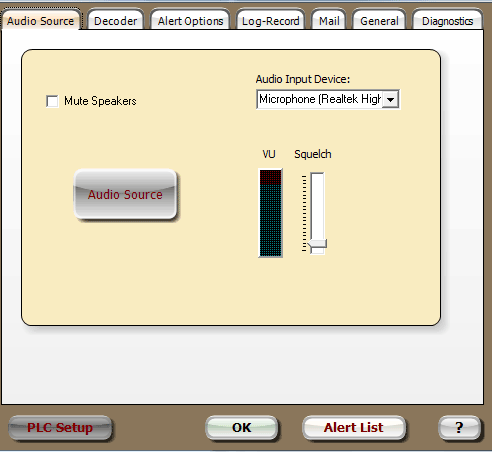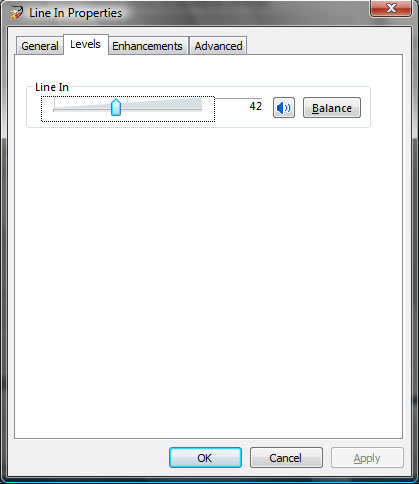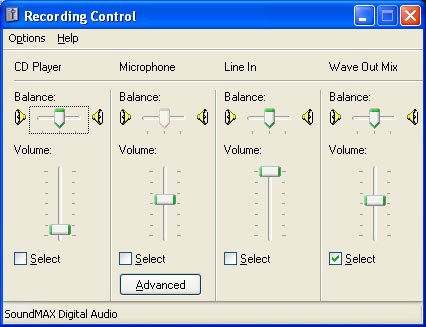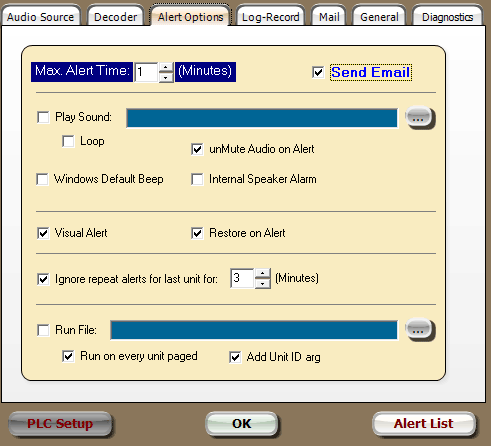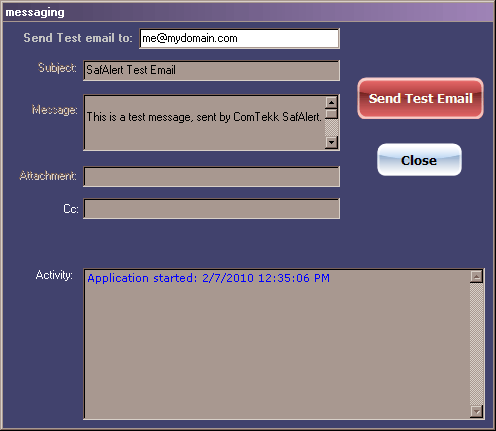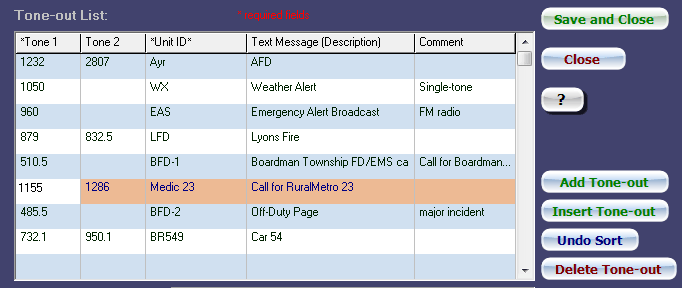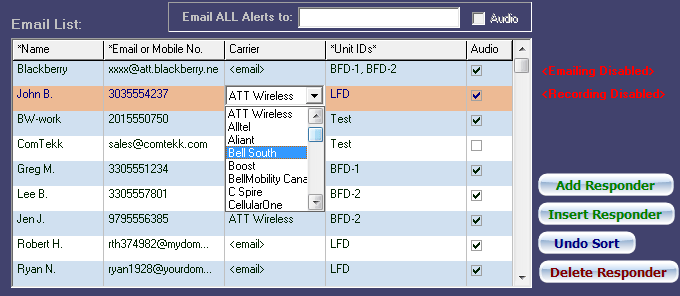SafAlert Notifier

SECTION V. Software Setup
NOTE: Click on red text for more details on highlighted item
CONTENTS
- Install
- Configure SafAlert Audio Settings
- Decoder Settings
- Alert Options
- Logging & Recording
- Mail Setup
- Test Email Settings
- General Options
- Diagnostics
- Tone-out List
- Email List
1. Install SafAlert
If you haven't already, install the software and enter registration key if you already have one. Connect receiver audio to the computer.
2. Configure SafAlert Audio Settings
NOTE: All settings are saved when OK is clicked and upon exiting SafAlert. Click the "?" button to display Help (this file).
2.1 Run SafAlert. Select Setup -> Preferences from the main menu. Click the Audio Source tab in SafAlert Preferences window.
2.2 Audio Input Device - Select the desired audio input device. This must be the input that your radio's speaker output is connected to.
SafAlert audio source controls2.3 Click the Audio Source button to open the Windows recording device selection dialog (See Fig. 1 below).
2.4 Be sure the Mute box is un-checked. Listen for receiver audio through computer speakers - it should be clear and crisp. Watch VU meter for level well into the blue, peaking in red is ok. Adjust the level control below Input Source as needed. It may also be necessary to adjust the receiver's volume control. If level is too high, decoder will not function properly!
2.5 The Squelch control should normally be set to a level in the lower blue range of the VU Meter. The default setting will work fine in most cases.
Fig. 1 Windows Recording Control Panel
WINDOWS 7 & VISTA:
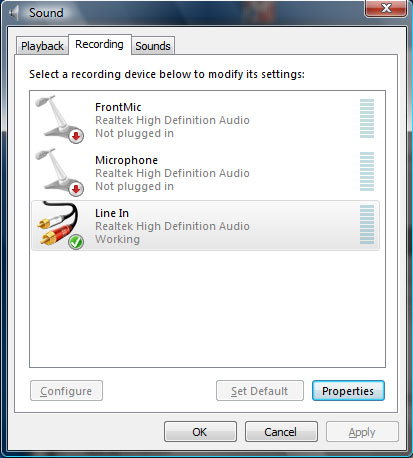
Windows 7 / Vista recording device selection (left) and properties (right).Click once to highlight the desired input device. If more than one device is available, click the Set Default button to make it your default recording device. Click Properties, then select the Levels tab to adjust the input level of this device as described in step 2.4 above. NOTE: The input level will not affect what is heard through the computer speakers!
WINDOWS 2000/XP: Choose the appropriate input line where your receiver's audio cable is connected. Click the Select checkbox to use this input, then use the corresponding Volume control to adjust the input level of this device as described in step 2.4 above.
NOTE: The input level will not affect what is heard through the computer speakers!
Windows 2000/XP Recording Control Panel
3. Decoder Settings
3.1 Decoder tab: In most cases, these settings should not need adjustment.
3.2 Trigger Settings - please note the time settings (Seconds, milliSeconds [mS]) are APPROXIMATED for the sake of simplicity. This setting must be LESS than the shortest tone duration.
It is highly recommended you do not change these settings unless you know they must be changed, or as directed by ComTekk Support.Single-tone - Duration of tone that will trigger a single-tone alert (default is 4 Seconds). Most common single-tone alerts have an 8-Second duration. As a rule of thumb, the trigger setting should be about half 3/4 of the expected tone. If the long tone is 8-seconds, use a trigger of 4-6 seconds.
2-tone - Duration of each tone that will trigger a 2-tone alert (default is 600 mS) 100mS = 0.1 Second
The most common 2-tone alerting format is a 1-sec. tone followed by a 3-sec. tone. As a rule of thumb, the trigger setting should be about half of the shortest tone. If the shortest tone duration is 1-second, use a trigger of 600 milliseconds.Tolerance - Determines how close decoded frequency must be to those entered in the Tone-out List. Increase this setting if you are not sure of the correct tone frequency, or if your sound card is off-frequency.
Restore Defaults - use to restore the recommended default decoder settings.
3.3 Advanced - Clicking the Capture Last button after a tone dispatch is received, will display the tone frequencies to be entered in the Tone-out List. Use this feature to identify unknown tones. This read-only box is provided as a convenience and has no affect on program operation. If you wish to discover tone frequencies for a number of departments/agencies, we recommend ComTekk's Multi Decoder.
Notch Filter - This is provided for installations where audio is tapped directly at a tone-remote control line. The default 2175 Hz is the most commonly used guard tone. Check the box to activate filtering. This will provide a 3dB band-stop filter, and the decoder will ignore this specific frequency, allowing it to decode paging tones normally. The guard tone will be effectively removed from recorded audio as well. This option should only be enabled when required.
Pager Test Tones - This feature will disable the tone decoder for the period of time specified in Test Duration. When the Test Tones are decoded, all subsequent tones will be DISREGARDED for the Test Duration (minutes). DO NOT use your normal pager tones here! A unique set of tones or single tone must be transmitted by your dispatch to utilize this feature. If using a single-tone page, enter it as the 'A' tone, and leave 'B' blank or zero.
3.4 PLC Setup - click to open PLC window. If not licensed for this feature, button will be disabled. See Section VI. PLC Setup.
4. Alert Options
4.1 Audio/Visual alerts: Click on the Alert Options tab. These settings determine what actions will be taken when an alert is detected. Most of these items should be self-explanatory, but brief descriptions will be provided here. See the manual for complete details.
Max. Alert Time - determines how long (in minutes) the following audio/visual alerts will repeat. Clicking the RESET button on the main screen will cancel the alert.
Play Sound - plays a sound file selected by clicking the
button. The sound file selected should be .WAV type. Check the Loop box for continuous repeat.
Internal Speaker Alarm - Plays a hi/lo alarm through the computer's internal speaker if so equipped.
unMute Audio on Alert - Causes the receiver audio to play through speakers when an alert is received.
Windows Default Beep - Repeatedly plays the "Default Beep" Windows event sound.
Visual Alert - This will cause the main screen to flash red during an alert. The tray icon will also flash if program is minimized.
Restore on Alert - If minimized, will restore the program window.
Ignore repeat alerts for last unit - Some dispatchers will always send the same call twice to in case some units did not receive it the first time. This option will help prevent duplicate emails/recordings from being sent for every call. This applies only to the last set of tones received. One minute is the default setting.
Run File - A powerful feature, launches any external program, script or associated file when alert is received. Click the
button to select a file. HINT: Test this action by navigating to the file you want to run using Windows File Explorer or My Computer, then double-click on the file.
Run on every unit paged - When enabled, will launch the Run File every time alert tones are received. For example, if two units are paged at once, the file will be launched twice. This option should normally remain disabled (unchecked).
Add Unit ID arg - adds the Unit ID as a command line argument when Run File is launched. This option should normally remain disabled (unchecked).
5. Log & Record Options
Controls event logging, audio recording and emailing features.
Alert Logging:
Log Alerts - Check this box to enable event logging to CSV text file. A dialog will open allowing you to select the log file name, as well as the Logs/Recordings Folder. Log files and recorded WAV files will both be stored in this folder. Mouse over to see complete folder name.
Logs/Recordings Folder - To change the location where alert logs and audio recordings are stored, un-check Log Alerts then check it again. This will bring up the open file dialog.
Audio Recording:
Record Alerts - Enables recording of MP3 audio file when an alert is detected. The file name will be added to the log along with date/time, Unit ID.
Select the duration of recording. The default of 30 seconds is usually long enough to capture critical dispatch information. Keep in mind, longer recordings mean larger files which take more time to send and receive. It's best to keep this time as short as possible. When this box is checked, Log Alerts will be automatically enabled.
Audio File Format - Select audio file recording bitrate. 48kbps is currently required for delivery to AT&T phones via MMS. 16kbps will produce a much smaller file, which will take less time to send. As of this writing, AT&T wass transitioning to new MMS gateway servers which will handle more file types. Expected deployment is some time in 2011.
Record Mode, Delay- Three modes of recording are available:
- Immediate - No delay. Recording will start immediately upon receipt of first tone-out. One or more tones may be heard in the recording.
- Timed Delay After Tones (recommended)- Recording starts after tones have been sent + Delay seconds. If you commonly receive "stacked" pages for 2 or more departments at a time, a minimum setting of 3 Seconds is recommended.
- Voice Detect - Recording starts after tones, but not until voice is detected, or maximum Delay seconds if no voice detected. Max. delay is 30 seconds.
6. Mail
Click the Mail tab to access these settings.
6.1 Mail Server - To utilize the email feature, you must have an email account. Most ISPs provide at least one email account - we recommend using this account for best reliability and least hassle. Auto Configure is provided for some of the most common email providers.
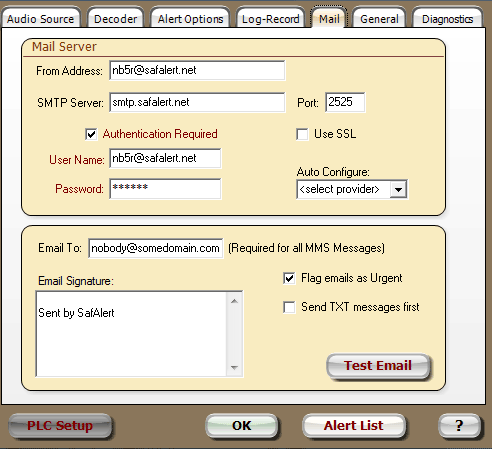
First click the Auto Configure drop-down to see if your mail provider is listed. Making a selection here will populate the basic settings for that particular provider. A message box will appear, prompting you to enter your email address, and account login & password. If your provider is not listed, consult your provider for outgoing (SMTP) mail configuration. This information is usually available on the provider's support web site.
Email Address - enter the complete email FROM address for the account you will be using to send mail.
SMTP Server - This is your OUTGOING mail server address, as provided by your email service.
Port 25 is the standard for outgoing email - do not change unless you know the specific port number.
NOTE: Most ISPs are now blocking port 25 as an anti-spamming measure - you can try using port 587 as an alternate.Authentication Required - Some ISPs don't require a login/password if you are connected to their network. If this box is checked, you must provide the User Name and Password.
Use SSL - Some mail servers require a SSL connection (Secure Socket Layer). SafAlert V.3 now supports this feature using Stunnel. Most free webmail services such as *Gmail, Hotmail, Yahoo! require SSL. Ports 465 and 587 are most commonly used for outgoing SSL. Port 25 is generally NOT used with SSL connections. If you're not sure, try sending a test message with this box checked or unchecked to see which works.
*IMPORTANT NOTES: GMX service has proven less than reliable. Webmail servers will usually block your account if more than 5-10 messages are sent at once! We highly recommend using your ISP or ComTekk's low-cost SMTP service.
6.2 Message settings (lower panel)
Email To: - (Required) email address for all mail messages with audio file attached [MMS]. A single email will be sent with up to 10 responder addresses hidden in the Bcc (Blind Carbon-Copy) field. By sending a single email to as many as 10 responders at once, the time required to send notifications is greatly reduced. This recipient will receive one or more copies of every alert sent! You can use a 'fake' address here to prevent this, but it must be formatted as a valid email "name@somedomain.com" The BCC method also greatly reduces the volume of mails being sent, thus reducing the likelihood that your account might be suspended for suspected spamming.
Flag emails as Urgent - All alert messages will be marked as "Urgent". Note that not all email programs or services will utilize this flag.
Send TXT messages first - When checked, SMS or TEXT-ONLY messages will be sent immediately after tones are decoded, otherwise they will be sent after audio recording has finished - at the same time MMS or emails with audio are sent.
Signature - The text entered here will be placed at the end of every alert email sent. It should identify the sending agency, contact name/number and may include a short disclaimer.
Note that using a long signature could cause the received message be truncated or split into 2 or more messages when sent to a mobile MMS/SMS address - these are usually limited by the carrier to between 140-240 characters total.
7. Test Your Email Settings
7.1 To check your Mail Server settings, click the Test Email button in the Mail tab of the Preferences window, which will open the messaging window (shortcut is Ctrl+M):
7.2 Enter a recipient's email address for testing (preferably an account you have immediate access to), then click Send Test Email. Normally the sending process shouldn't take more than half a minute. You can monitor progress in the Activity window. Below is an example of a successful transmission, ending with the message "Connection closed." Any error messages displayed here will aid in troubleshooting your email settings.

Activity / Event log view7.2.1 Upon successful send, check the Inbox of recipient email address. Depending on the service and software, the test email could appear immediately, or take a few minutes or more.
NOTE: There is no way to control how quickly an email or MMS/SMS is delivered once it has been sent.
7.2.2 Click the Close button when you have finished testing.
8. General Settings
8.1 Program Control - various program behavior settings
Start Minimized - Causes SafAlert to launch in minimized state. When SafAlert is minimized, only the tray icon
will remain visible in the lower right-hand corner of the Windows Desktop.
Stay on Top - Keeps SafAlert window on top of all other windows if multiple programs are open.
Start with Windows - Loads SafAlert automatically when computer is booted.
Confirm Exit - If enabled, this option will cause a dialog box to open when exiting the program asking you to confirm. This can help prevent a user from stopping SafAlert accidentally.
8.2 Security - When this box is checked, a password will be required to access the Preferences window.
Enter your password carefully and keep it in a safe place. Password reset requires contacting Tech Support...
Click the Change button. Enter password in the text box, then click the Set button. Password is case sensitive. The default password is "test"
Alert List - Enables password protection for the Alert List.
PLC Settings - Enables password protection for the PLC (X10) settings.
9. Diagnostics
9.1 SMTP Logging - Enable this checkbox to log email activity for troubleshooting. File name is "smtp.log", found in the program folder and may be viewed with Notepad or any text viewer/editor. Note this file can become very large if left active for a long time. For this reason, the SMTP Logging defaults to "OFF" when starting SafAlert. For more info, see the Troubleshooting FAQ.
9.2 Test SMTP Server - Used to periodically test communications with your email server. If the test fails, the Mail Server status indicator on the main screen will turn yellow. If the test is good on the next try, status will return to green.
9.3 Show messaging window while sending - provided as an additional aid for troubleshooting email problems.
9.4 Show manual test menu - Displays a menu for manually stepping through each task when sending a test email. Connect to server, send mail, disconnect. This is provided as a troubleshooting aid.
9.5 Save event log on exit - upon exiting SafAlert, the contents of the "Activity" box on the messaging window will be saved to the file "mail.log", found in the logs/recordings folder and may be viewed with Notepad or any text viewer/editor. For more about files see Appendix C.
9.6 Info - Additional information is provided for convenience at the bottom left panel of the Diagnostics window.
First is the Windows OS Version. Below, is the computer's local IP address. Mouse over <AppDir> or <AppDataDir> to reveal file locations for the application and data folders. Tone-out and Email Lists are contained in the AppDataDir and program log files are stored in the AppDir. The alert log and audio recordings are saved in the folder shown on the Alert Options tab. For more about files see Appendix C.
9.7 Stats - Program statistics information is provided at the bottom right panel of the Diagnostics window.
Start date - beginning date for statistics.
Members - current number of active members in Email List.
Messages sent - running total of email messages sent.
Alerts received - running total of tone alerts received.
Audio recordings - running total of audio recordings made.9.8 Calibration Factor - May be used to compensate for a sound card's internal clock error. Changing this value to an incorrect setting can cause the decoder to malfunction! This should only be modified by an experienced technician. Default setting is 1.0
MANUAL CALIBRATION INSTRUCTIONS:
- Connect output of sound card to a calibrated frequency counter set to maximum resolution. This will likely mean using a 10-second or longer timebase setting.
- Click the Cal Tone button to Start the 1kHz calibration tone.
- Adjust computer's main volume control as needed to get a valid reading on counter.
- Note exact frequency on counter display. It should be somewhere near 1000 Hz.
- Calculate the Calibration Factor as: (1000 / counter freq.)
- Click the Cal Tone button again to Stop the 1kHz calibration tone.
- Enter calculated value in Calibration Factor field. Click OK when finished.
10. Tone-out List
10.1 From the Preferences window, click the Alert List button in the lower right corner, or from the Main Menu, click Setup -> Alert List.
10.1.1 Start with the top section "Tone-out List" Click the Add Tone-out
button to make a new entry. This entry will be inserted into the next available empty row. Click on the highlighted area to begin editing. Use the Tab key to move cursor to next field. Click OK or press Enter key when finished editing entry. A new entry may also be inserted above the current highlighted row using the Insert Tone-out button. To use the insert feature, a row must be highlighted (click anywhere on the row to highlight).
To edit an existing entry, simply roll the mouse over that row and click it.
To sort the entries, click on the column heading, for example to sort entries by unit name, click on the Unit ID heading. Click again to invert sort order. The Undo Sort button will return entries to their original order.
10.1.2 Enter each tone frequency in Hertz (Hz). If there are two tones, they MUST be in order, first tone is Tone 1, second tone is Tone 2. For single-tone alerts, Tone 2 should left blank. See examples above.
10.1.3 Enter a unique Unit ID. This should be the same or similar to over-the-air unit designator. Important note: Unit ID is the key field used to match alerts to corresponding emails.
Be sure each Unit ID is unique and not contained in part of another. For example:
Truck-7
Truck-71This will cause Truck-71 to also receive calls for Truck-7. Instead, use Truck-07 as the ID.
10.1.4 Enter Text Message - this text will appear in the body of alert emails or MMS/SMS text message if sent to a mobile phone.
11. Email List
11.1 To access the Email List: From the Preferences window, click the Alert List button in the lower right corner, or from the Main Menu, click Setup -> Alert List.
To edit an existing entry, simply click on it. To sort the entries, click on the column heading, for example to sort entries by unit name, click on the Unit ID heading. Click again to invert sort order. The Undo Sort button will return entries to their original order. To delete an entry, click on it (single-click) to highlight that entry, then click the Delete Responder button.
11.1.1 To add a new entry, click the Add Responder
button. Click on the highlighted area to begin editing. Use the Tab key to move cursor to next field. Click OK or press Enter key when finished editing entry. A new entry may also be inserted above the current highlighted row using the Insert Responder button. To use the insert feature, a row must be highlighted (click anywhere on the row to highlight).
Name - recipient's name, anything can go here.
Email or Mobile No. - Enter recipient's email address OR 10-digit mobile phone number (digits only, NO spaces or puctuation!).
Be sure to have all mobile recipients check their calling plan allowances before using this feature. Many wireless carriers charge extra for text/MMS messaging.
Carrier - A drop-down list will appear when you click on this field. Select <email> if you entered an email address. If a mobile phone number was entered, select the mobile user's carrier (service provider) from the list. If the carrier is not listed, select <email> and use one of these to locate SMS/MMS gateway:
http://www.mutube.com/projects/open-email-to-sms/gateway-list/
http://en.wikipedia.org/wiki/List_of_SMS_gateways
If sending audio, you must use the MMS address. SMS is for TEXT-ONLY messages.
Audio - Check this box to send audio attachment. If not checked, a text-only notification will be sent. For mobile numbers, audio attachments are sent using MMS and text-only messages via SMS.
Unit IDs - Critical field: This entry must exactly match the correct Unit ID in the Tone-out List above. Emails will not be sent to incorrect entries - they will simply be ignored. Multiple Unit IDs may be entered and must be separated by a comma and/or space. For example, when tones are decoded for unit id "EMC", an email/MMS will be sent to John Smith, along with any other responders with unit id "EMC"
For example, when tones are decoded for unit ID: "EMC", an email/MMS will be sent to John Smith, along with any other responders with unit id "EMC"
Be sure each Unit ID is unique and not contained in part of another. For example:
Truck-7
Truck-71This will cause Truck-71 to also receive calls for Truck-7.
To avoid this scenario, use "Truck-07" as the Unit ID for Truck-7.
11.2 Save alert lists:
Click Save and Close once you are satisfied all entries are correct.
11.3 To send a "carbon copy" of EVERY alert message, enter recipient email in "Email ALL Alerts to" box. If Audio is checked, audio file will be sent along with email.
WARNING: Using this feature can result in a very large amount of email being sent to this recipient.
11.4 <Emailing disabled> status indicates alert messages will NOT be sent. To enable, click Send Email in Alert Options tab.
11.4 <Recording disabled> status indicates audio recording is disabled. To enable, click Record Alerts in Log-Record tab. It is recommended that the Log Alerts box be checked also.
Final Step: Save alert lists
Click Save and Close once you are satisfied all entries are correct.
Congratulations! You should now be ready to start using SafAlert. Testing is highly recommended. This may require asking your dispatcher to transmit one or more test pages to ensure everything is working properly and all intended recipients are able to receive their alert messages.
PLC Setup:
Click to open PLC window. If not licensed for this feature, button will be disabled. See Section VI. PLC Setup.
Next section: Using SafAlert
Disclaimer:
Actual performance may vary between different computers and sound cards. The author makes no warranties or guarantees of performance or suitability for any particular purpose, and assumes no liability whatsoever for the use or misuse of any software products. This product is not intended for use as a primary means of notification. The author cannot guarantee timely message delivery and has no control over the Internet, third-party mail servers, or carrier networks.

